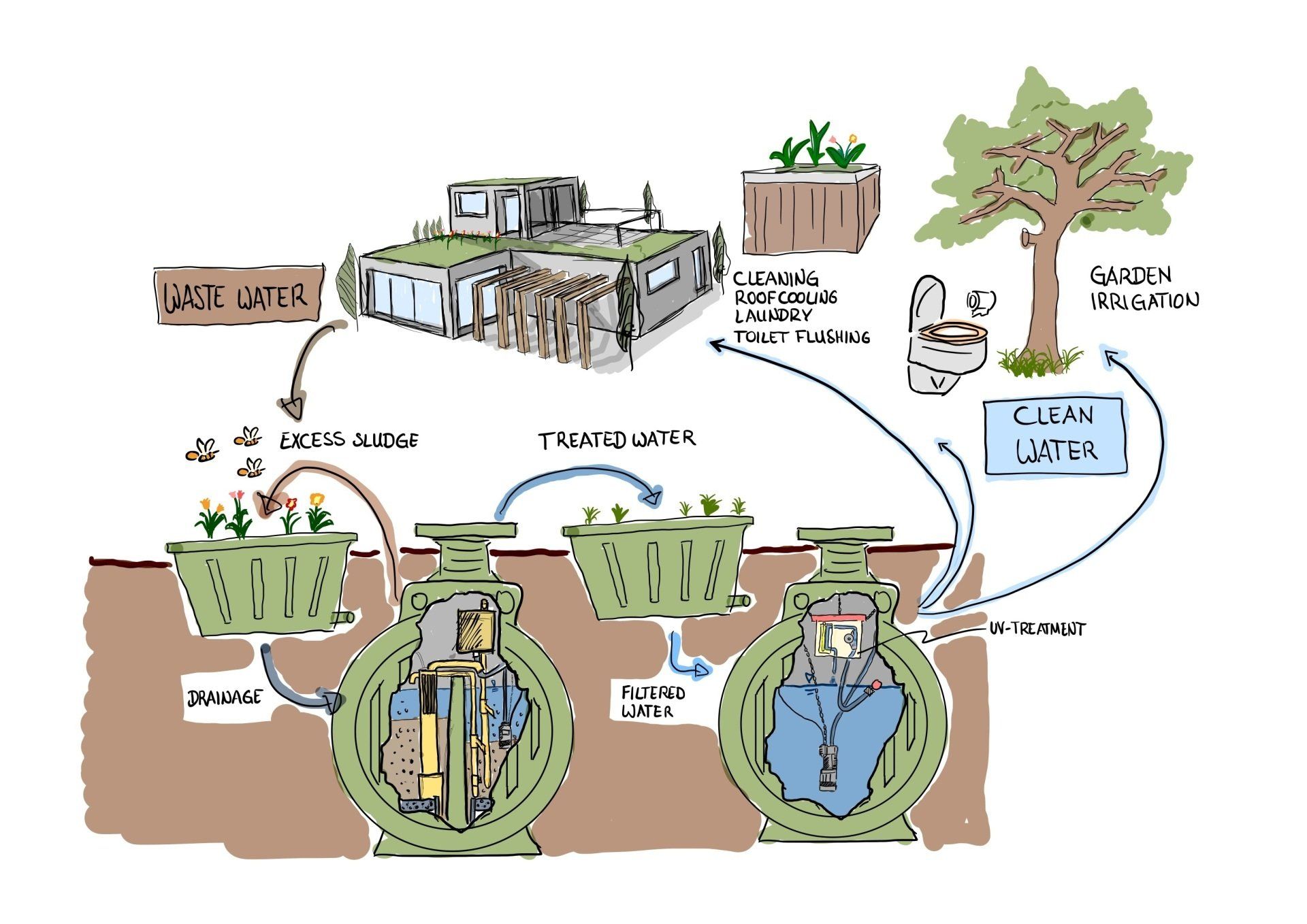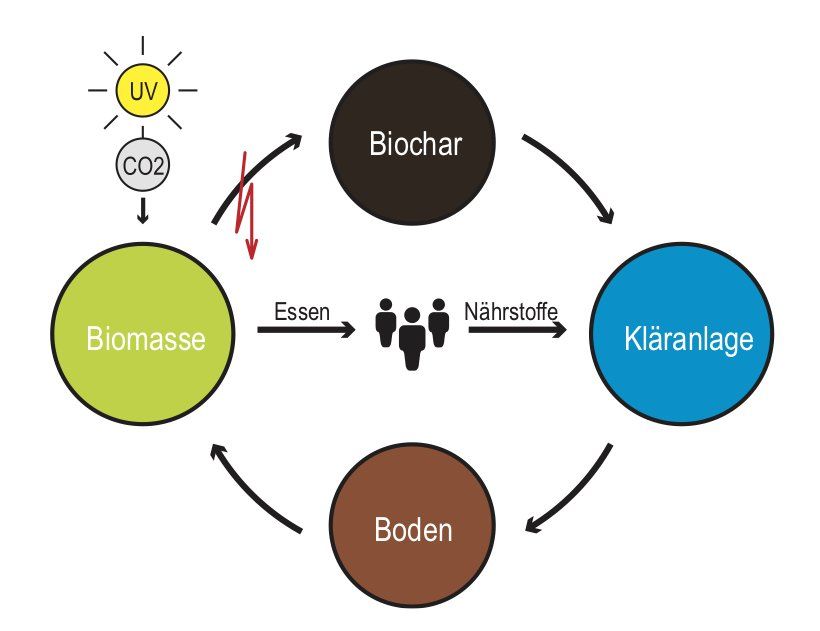water cycle use
Water without restrictions - our recirculation systems clean your gray water (shower, bath and washing water) or black water (all waste water including toilet) without the use of chemicals in a purely biological-mechanical way so that it is germ-free in accordance with the EU directive for clean water bathing water is. You simply use the treated waste water a second time: for flushing the toilet, washing clothes, cleaning the house or watering the flowers.
We carry out regular maintenance and repairs for systems that use the water cycle. We also offer planning and installation, as well as sale and delivery. Please get in touch with one of our contact persons, we will advise you individually on your request.
Advantages:
When drinking water becomes scarce during long periods of drought and official restrictions on water use are imposed (e.g. ban on irrigation), the rainwater storage tanks have long since dried up. Become self-sufficient in water through recycling, make yourself independent of usage restrictions or simply save on drinking water and water charges.
Our water reuse systems can also be manufactured as a container solution and customized by our Tiny House Munufakturpartner.
Where wastewater is produced and there is no possibility of discharging wastewater into a public sewer or treating wastewater and discharging it into a body of water, a water reuse system can also be operated as a drainless pit. Use your waste water several times, irrigate according to "good agricultural practice" and save on disposal costs and environmental pollution.
The recycling water use of waste water is particularly suitable for:
- toilet flushing irrigation washing water cooling water
Buildings with high demand are for example:
Our system is used at
- Tiny housesurban evaporative cooling dormitoriescamping sitesrest areasrefugee and catastrophe aid
waste water recirculation systems
With waste water recirculation systems, even highly contaminated waste water contaminated with faeces can be processed into high-quality process water. BioTopp small wastewater treatment plants achieve an extraordinarily high nutrient removal and are therefore the optimal basis for a wastewater recirculation system. Similar to drinking water production, the biologically cleaned and clear water is first filtered through an overgrown layer of soil. In a deeper layer of biochar and sand, trace and odor substances are bound and microorganisms ensure further cleaning and additional operational safety. Depending on the size of the system, UV disinfection in the storage tank or on the service water pressure line ensures safe sanitation in front of the consumer.
gray water systems
Gray water systems are used to treat slightly contaminated shower and bath water and washing water into high-quality process water. A gray water system consists of mechanical pre-cleaning for the separation of solids, a membrane bioreactor and a service water collection tank. Depending on the load, biological cleaning can be supplemented by a biofilter to improve nutrient elimination.
Mud terracing
The soiling stage BioTopp VE supplements the sewage treatment plant system BioTopp (SBR), B2000 (continuous flow system) as an expansion module and can optionally also be used in other systems with activated sludge stabilization. The product of mud soil is dried mud soil, which can also be used as a fertilizer for shrubs and ornamental gardens. The content of the soil basin consists of a lower drainage layer and an overlying layer of sand, on which plants can also be established. When excess sludge is drawn off, one of the two chambers of the siltation basin is charged. Subsequent seepage leads to dewatering of the sludge. An additional reduction in volume is achieved by exposure to the sun (formation of palm-sized flakes on the surface of the pool, thickness 3-5 mm). In addition, weathering and biological degradation cause the sludge to become sanitized. After about half a year (spring-autumn) or a year (autumn to autumn), the dried sewage sludge soil can be removed from the first chamber.

Legend:
A: Gravel or Split 1/3
B: Biochar 0/5
Experiences with sludge soiling show that in a 4-person household only 4 to 5 kg of dried sludge soil accumulate per year. In contrast, in a sewage treatment plant with primary treatment, around 2,000 kg (2 m³) of faecal sludge must be pumped out and treated further in a municipal sewage treatment plant. Although sewage sludge disposal is usually subsidized in practice, it is a significant part of the operating costs for the operator of a small sewage treatment plant. In the case of sludge humification, on the other hand, there is the possibility of taking the dried sludge earth with us during a maintenance tour due to the small quantities and having it recycled properly.
Note: Sewage sludge soil is a high quality fertilizer and soil conditioner. It has a high humus value, a low salt content compared to compost and a high-quality organic component for the production of soil and substrates. Furthermore, the material is harmless in terms of epidemics, easy to process and has a high chemical and mechanical stability (Dr.-Ing. Günter Fehr, Dr.-Ing. Udo Pauly: Development, construction and operation of eco-technical plants).
Recontamination of the earthed sludge is avoided by alternating loading of the sludge with subsequent drying and mineralization. A possible use of the dried sludge is to use it as a fertilizer for shrubs and ornamental gardens.
With the amendment of the fertilizer and sewage sludge ordinance, the possible uses have been severely restricted today, which is why we offer take-away and orderly recycling as part of our maintenance service.
Terra Preta Sanitation - current situation
The urban population's food and energy needs are mainly met by rural areas. The lack of reuse leads to the loss of water and nutrients. The result is degradation of groundwater and soil, eventually leading to desertification and reducing the ability of rural areas to support the population. The need for proper wastewater treatment is critical to avoiding waterborne diseases and rising costs of drinking water treatment. The NAFASAN concept for decentralized water reuse can prevent these problems and ensure better future conditions.
The amortization example (left) shows a 60% increase in rice yield with an average biochar input of 10 tons per hectare. From year to year, more agricultural land can be cultivated with Terra Preta substrate. Land accumulation also increases the overall yield increase. The graphic shows the amortization time of various parameters. The green line shows that the population connected to NAFASAN can feed themselves after 4 years from the surplus rice that has arisen. The cost of the charcoal (3 years) and energy (7 years) required for waste water treatment is also covered after a relatively short period of time. The costs for waste water treatment are basically self-supporting; rather, the operation of the sewage treatment plant generates income for present and future generations. The NAFASAN concept with its sustainable character represents a powerful tool to combat food shortages, increasing energy needs and climate change in general.
Biomass
The Climate-Sol Foundation has developed a key concept to turn unwanted or unused waste biomass that is currently only burned in the fields into a valuable fuel for power generation or cooking. In addition, Climate-Sol uses the highly fertile Typha latifolia (Broadleaf Bulrush), which invades the rice paddies of Senegal and Mali. Converting this threat into a fuel could easily meet 50% of West Africa's (UEMOA) energy needs.
Biomass to Biochar
The households that cook with a pyrolysis stove convert pellets into biochar, saving 80% of energy compared to traditional wood burning. On a municipal or industrial level, modern combined heat and power plants use rice husk or typha to simultaneously generate electricity, heat and biochar.
Biochar
Just using untreated biochar has great advantages as a soil improver. It serves as a habitat for microorganisms and supports plants in their metabolic processes, eg in providing atmospheric nitrogen. In addition, biochar helps to improve the yield of poor soils because it stores nutrients and improves water retention. On the partner rice farm in Senegal, saline soils were able to be regenerated and yields increased from 3.5 t per hectare to up to 8 t per hectare simply through the use of biochar.
Biochar for wastewater treatment
The mixing of biochar with secondary sludge from sewage treatment plants is state of the art and known as a soil improver due to the adsorption of biomass and nutrients. The idea of integrating biochar into the treatment process itself came from Ökoservice and is already being used. Activated microorganisms can accelerate charcoal biological aging, which improves cation exchange capacity and reactivity. The mobilization in the water also helps to enrich nutrients and microorganisms and to use biochar surfaces efficiently.
waste water treatment
The BioTopp sewage treatment plant with sludge humification developed by Ökoservice (today ECO Water Solution) has been used successfully for many years. The increased biological phosphorus removal enables a high recovery rate as phosphorus is enriched in the mud soil. Smaller space requirements and very extensive denitrification (N anorg < 10 mg/l) combined with high energy efficiency are strong arguments for integration into the NAFASAN concept for the production of terra preta substrates.
Wastewater treatment to soil
Safe reuse of water and terra preta substrate is realized with cheaply available technologies. UV disinfection removes bacteria and viruses from the treated wastewater. Thermal disinfection is suitable for killing highly resistant worm eggs in the Terra Preta substrate. In this way, heat from the sun or secondary heat from a combined heat and power plant can also be used.
floor
Indigenous peoples created the famous terra preta soil by mixing charcoal with leftover food and feces. After thousands of years, this soil is still very fertile and gets even better with the passage of time. In addition to water and nutrient storage, improved soil biodiversity is beneficial for agriculture.
soil to biomass
Depending on the soil quality, a yield increase of up to 100% can be observed. Further benefits are achieved through the reduced need for fertilizer and irrigation water. The sensational advantage of Terra Preta with the NAFASAN concept is the progressive and sustainable soil improvement that gives us the opportunity to make the earth a better place for present and future generations.










